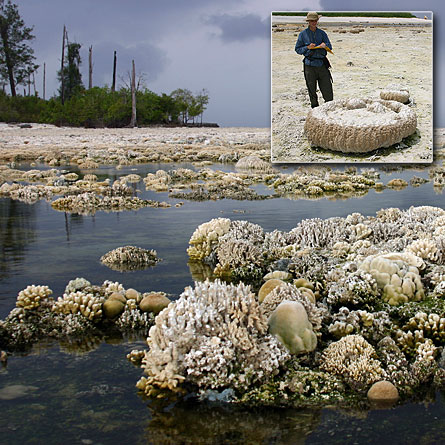The magnitude-8.4 and -7.9 quakes that slammed the Mentawai Islands southwest of Sumatra in September 2007 are likely just the first in a series of major temblors that will strike that region in the coming decades, new analyses of the archipelago’s coral reefs suggest.

Certain species of corals naturally record sea level: Because these creatures grow to the ocean’s surface but die if they’re dry for more than a few minutes, the height of a coral colony’s uppermost surface denotes a site’s lowest tide, says Aron Meltzner, a geologist at the California Institute of Technology in Pasadena. A sudden and substantial shift in local sea level triggered by uplift after a major earthquake will kill such corals, while quake-induced sinking of the ground will be recorded in a colony’s growth patterns (SN: 4/1/06, p. 197).
Now, analyses of corals surrounding the Mentawai Islands indicate that the region has suffered repeated cycles of seismic upheaval for at least seven centuries. Results of the new studies, reported by Meltzner and his colleagues in the Dec. 12 Science, don’t bode well for the region’s near future.
Many of the islands west of Sumatra have been shaken by massive temblors in recent years, including the magnitude-9.2, tsunami-triggering quake of December 2004 (SN: 1/8/05, p. 19) and a magnitude-8.6 follow-up that struck just three months later (SN: 4/2/05, p. 211). Such quakes occur when tectonic plates — one of which is forced beneath the other along a lengthy subduction zone — slip past each other, says Meltzner. Until September 2007, the longest stretch of subduction zone off Sumatra that hadn’t recently slipped sat beneath the Mentawai Islands. That 700-kilometer-long segment had been seismically calm since major quakes struck the region in 1797 and 1833, Meltzner notes.
A field study of corals in the area struck by the September 2007 quakes shows that some sites in the Mentawai Islands — as well as the reefs just offshore — rose about 73 centimeters as a result of the temblor. At one site near the village of Bulasat, comparable episodes of uplift, also recorded in corals, occurred around 1347, 1607 and 1797. Each incident triggered widespread coral deaths, but the long-lasting mineral structures built by the colonies enable scientists to estimate the dates of the massive quakes that caused those upheavals, says Meltzner.
Analyses of corals at nearby sites tell similar but slightly different stories. At Simanganya, about 60 kilometers northwest of Bulasat, coral-killing uplifts occurred in 1381, 1560, 1613, 1797, and 1833. This site, however, was unaffected by the 2007 quake, says Meltzner. At Sikici, even farther to the northwest of Bulasat, substantial uplifts occurred in 1374, 1596, 1675, 1797, 1833 and 2007.
Together, the data indicate that the region has suffered several series of major quakes, each of which lasted between a few decades and a century. These “supercycles” of quakes begin to unfold, on average, every 200 years or so, says Meltzner. The broad pattern of coral deaths also hint that the sequence, size and location of quakes vary from one supercycle to the next.
The new findings “are a major advance in the understanding of the way the earthquake cycle works” in this region, says John McCloskey, a geophysicist at the University of Ulster in Coleraine, Northern Ireland. The results show that each cycle is more complicated than previously thought and that quake patterns within any particular supercycle don’t match those seen in the other supercycles, he adds. Expecting otherwise “would be like setting off a series of bombs in the same place and expecting the rubble pattern from each one to be identical,” he notes.
Meltzner and his colleagues suggest that the Mentawai Islands’ September 2007 temblor is the opening salvo in a new supercycle of quakes for the region. If so, the coming years could be devastating indeed, says Yehuda Bock, a geophysicist at Scripps Institution of Oceanography in La Jolla, Calif. He and his colleagues — a group that also includes Meltzner — reported in the Dec. 4 Nature that the region’s 2007 quake released only one-quarter of the energy that had accumulated along this stretch of subduction zone since 1833. So, Bock notes, quakes in the region in the coming decades may be even larger than expected.
“This is the best area in the world to be able to predict a quake,” Bock says. “It’s clear that there’s going to be an event … We just can’t say for sure when it will happen.”






